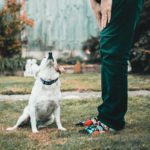Expert bird dogs do not grow on trees.
Sure, they may have been through generations of selective breeding in order to optimize their bird retrieving qualities, but that does not mean that they are born knowing exactly how to behave in the field. Retrievers are not mind readers.
In fact, training bird dogs can be more difficult than ever these days, precisely because of the qualities we have bred into them.
Labradors and other bird dogs are often hyperactive and unruly due to their high intelligence and heightened sensory powers, and this can make it tricky to get them to retrieve as you would wish them to.

Of course, expert dog trainers don’t grow on trees either.
Whilst you might be a keen shot and an enthusiastic dog owner, that does not mean that you will automatically know exactly how to get your canine companion to respond to your commands.
It takes great patience and dedication to teach your dog to understand and obey your hand signals, whistles and wishes effectively.
Yet, once achieved, the bond created between man and beast is like nothing else, and the joy of working seamlessly together out in the field makes all the effort worthwhile.
The Role Of A Bird Dog
In general, bird dogs perform six different tasks whilst out on a hunt.
- Quarter – This is when they sweep back and forth in front of the hunter’s path through the field, bush or forest
- Seek Scent – They keep their nose to the ground, seeking out the scent of birds hiding in the grass or bush
- Steady – They stand still or ‘whoa’ when they detect a bird, and wait for the hunter to flush it out
- Point – They position their whole body, head, and nose in the direction of the bird in order to communicate its whereabouts to the hunter
- Fetch – Once the bird has been shot, the bird dog runs and picks up the kill wherever it has fallen. This could be in bush, forest or water. Sometimes they must do this ‘blind’, if they didn’t see exactly where it fell
- Retrieve – Finally, they carry the bird back with a ‘soft mouth’ hold, and deliver into the hunter’s hand
Common Difficulties
The final stage of this process (the retrieve), is the stage that most dogs struggle to master.
Many bird dogs chase after the birds too soon, rather than waiting for the command to ‘fetch’ from the hunter. Others damage the kill by retrieving it with a ‘hard mouth’ rather than a ‘soft mouth’.
And plenty of dogs refuse to carry the bird all the way back to the hunter’s hand, preferring to drop it half way so that you have to go and get it yourself.
With all that being said, let’s look at a few simple rules, tips and tricks that expert trainers recommend for getting your dog to retrieve birds on command efficiently and obediently.
Retriever Training, Tips And Tricks
Start Them Young
It is far easier to train pups than to break in older dogs who may have developed bad habits that are hard to reverse. For this reason, it is always best to start training your bird dog when they are young.
Beginning with foundational behavior training is key, because your bird dog will have to ‘sit’, ‘stay’ and ‘come back’ whilst out on a hunt, as well as fetch and retrieve.
Using treats to reward good behavior will communicate to your puppy that they have understood your commands correctly.
Clear Voice And Eye Contact
Using very clear and distinct command words or whistles will also make the lines of communication flow more smoothly between you and your pup.
Try deciding on a tone of voice for each command and sticking to it as closely as possible with every repetition.
Hand gestures are also really useful but they require eye contact, so always say ‘check’ to your puppy and make them look up at you before you give them a command.
The practice of gaining eye contact before you command will be really useful out in the field when you need to be quiet approaching your prey.
Leash Work
A really good tip is to begin practicing fetch and retrieves with your pup on a leash.
It can be a very short leash to begin with, and you can toss a ball or toy a few feet and then encourage them to bring it back to your hand by tugging gently on the leash.
As they become more proficient you can lengthen the leash and try only to tug when they do not return the toy themselves.
At this stage you should try introducing your pup to birds by using dolly birds that mimic the shape and size of a fallen bird, and by using bird wings and dead birds so that they get used to the smell and taste.
Carrying Practice
A bird in the mouth is worth two in the bush when it comes to retrievers, so practicing mouth carrying is important. A good bird dog should keep a soft mouth carry so as not to damage the kill.
Giving your pup a bird wing or dead bird to carry in their mouth as they walk to heel is a great exercise.
You can always walk them on a leash to begin with, and if they drop the bird, you can stop and encourage them to pick it up again before you continue with their walk.
Steady Before Fetch
When your dog is ready to join you on a shoot, you should not immediately launch them into fetching and retrieving duties. Instead, the focus should be on steadying, using the ‘whoa’ command.
This is because obedience and restraint are far harder and less instinctive for bird dogs than seeking and chasing, and it is unfair to expect them to perform these difficult tasks if they are also being encouraged to fetch and retrieve.
They will be eager to run after birds as soon as they spot them, therefore, keep your dog on a leash for their first few shoots.
Only once you are sure that they have understood and mastered the ‘steady’ command thoroughly, should you begin to give them the command to ‘fetch’ and ‘bring back’.
This can take many, many weeks and months for some dogs.
Positive Reinforcement
Once your dog is fetching and retrieving, use positive reinforcement to show them that they have done well.
Just like you did when teaching them to sit and stay as a pup, using treats and physical rubs and pats will communicate that you are pleased with them and will encourage them to repeat that behavior.
Methods To Avoid
Training a bird dog to retrieve does not happen overnight, and many owners grow impatient with the process.
There are some short-cut training techniques that certain trainers claim can speed up the process, however they can be harmful and distressing to the dog if they are employed by those who are not qualified.
As such, we highly recommend these methods are avoided:
Electric Collars
Although many trainers swear by these gadgets, electric collars can be very distressing for dogs if used incorrectly. The collars are designed to deter dogs from repeating bad behaviors.
The hunter presses a button that causes their dog to receive an electric shock via their collar. The shock is painful and confusing to the dog and can cause them to develop nervousness and erratic behaviors as a result.
Forced Retrieve
The forced retrieve is a form of negative reinforcement. It is when trainers push the head and nose of the dog down into the bird they wish it to retrieve until it picks it up.
This technique is rough and painful for the dog and can also be very abusive if misused.
A Note On Breeding
Finally, it is worth noting that the dog breed and breeder you choose will affect their retrieving abilities and tendencies enormously.
In America there has been a gradual move towards more energetic, intelligent and muscular traits in bird dogs, with heightened senses and physical stamina being genetically favored.
However, these traits result in hyperactive and stubborn dogs that are often very difficult to train.
Although training methods are effective, and it is possible to achieve great results with these dogs, the fact remains the puppies will be just as unruly and hard to train as their parents.
It is worth looking to Europe, and Britain in particular, when searching for breeders.
In Britain, obedience and docile traits are valued more highly during genetic selection, and as a result the bird dogs over there are far more easy to train, even for the ameteur trainer.
What is more, British bird dogs are bred to have a natural ‘soft mouth’ carry, something that is incredibly difficult to train in an American dog.
If you have the time and the inclination, you could save yourself lots of future difficulties by investing in one of these pups from the offset.
- 8 Signs That Your Dog Is In Heat - November 8, 2022
- Why Is My Dog Whining Whilst Carrying A Toy In Their Mouth? - August 17, 2022
- Reasons Why Your Dog’s Poop Is White And What To Do About It - August 17, 2022








